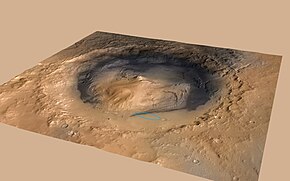
Back Gale (krater) Afrikaans فوهة غيل Arabic Кратар Гейла Byelorussian Гейл (кратер) Bulgarian Gale (cràter marcià) Catalan Gale (kráter) Czech Gale (Marskrater) German Gale (cráter) Spanish Gale'i kraater Estonian گیل (گودال) Persian
 Mount Sharp rises from the middle of the crater - the green dot marks the Curiosity rover landing site in Aeolis Palus (click the image to expand, the dot is barely visible at this scale.) North is down in this image. | |
| Planet | Mars |
|---|---|
| Coordinates | 5°24′S 137°48′E / 5.4°S 137.8°E |
| Quadrangle | Aeolis |
| Diameter | 154 km (96 mi)[1] |
| Eponym | Walter Frederick Gale |
Gale is a crater, and probable dry lake, at 5°24′S 137°48′E / 5.4°S 137.8°E in the northwestern part of the Aeolis quadrangle on Mars.[2] It is 154 km (96 mi) in diameter[1] and estimated to be about 3.5–3.8 billion years old.[3] The crater was named after Walter Frederick Gale, an amateur astronomer from Sydney, Australia, who observed Mars in the late 19th century.[4] Mount Sharp is a mountain in the center of Gale and rises 5.5 km (18,000 ft) high.[5][6] Aeolis Palus is the plain between the northern wall of Gale and the northern foothills of Aeolis Mons.[5][6] Peace Vallis,[7] a nearby outflow channel, 'flows' down from the hills to the Aeolis Palus below and seems to have been carved by flowing water.[8][9][10] Several lines of evidence suggest that a lake existed inside Gale shortly after the formation of the crater.[11]
The NASA Mars rover Curiosity, of the Mars Science Laboratory (MSL) mission, landed in "Yellowknife" Quad 51[12][13][14][15] of Aeolis Palus in Gale at 05:32 UTC August 6, 2012.[16] NASA named the landing location Bradbury Landing on August 22, 2012.[17] Curiosity is exploring Aeolis Mons and surrounding areas.[when?]
- ^ a b "NASA's Next Mars Rover to Land at Gale Crater". NASA. July 22, 2011. Archived from the original on May 11, 2020. Retrieved August 18, 2012.
- ^ USGS Gazetteer of Planetary Nomenclature. http://planetarynames.wr.usgs.gov/nomenclature/Feature/2071.
- ^ "Mars Odyssey Mission THEMIS: Gale Crater's History Book". ASU.edu. Retrieved August 18, 2012.
- ^ Wood, Harley. "Gale, Walter Frederick (1865–1945)". Biography - Walter Frederick Gale. Australian Dictionary of Biography. Retrieved August 18, 2012.
{{cite book}}:|work=ignored (help) - ^ a b USGS (May 16, 2012). "Three New Names Approved for Features on Mars". USGS. Archived from the original on July 28, 2012. Retrieved May 28, 2012.
- ^ a b IAU (May 16, 2012). "Planetary Names: Mons, montes: Aeolis Mons on Mars". USGS. Retrieved May 28, 2012.
- ^ IAU Staff (September 26, 2012). "Gazetteer of Planetary Nomenclature: Peace Vallis". IAU. Retrieved September 28, 2012.
- ^ Brown, Dwayne; Cole, Steve; Webster, Guy; Agle, D.C. (September 27, 2012). "NASA Rover Finds Old Streambed On Martian Surface". NASA. Archived from the original on May 13, 2020. Retrieved September 28, 2012.
- ^ NASA (September 27, 2012). "NASA's Curiosity Rover Finds Old Streambed on Mars - video (51:40)". NASAtelevision. Archived from the original on December 12, 2021. Retrieved September 28, 2012.
- ^ Chang, Alicia (September 27, 2012). "Mars rover Curiosity finds signs of ancient stream". AP News. Retrieved September 27, 2012.
- ^ Fairén, A. G.; et al. (2014). "A cold hydrological system in Gale crater, Mars". Planetary and Space Science. 93: 101–118. Bibcode:2014P&SS...93..101F. doi:10.1016/j.pss.2014.03.002.
- ^ NASA Staff (August 10, 2012). "Curiosity's Quad - IMAGE". NASA. Retrieved August 11, 2012.
- ^ Agle, DC; Webster, Guy; Brown, Dwayne (August 9, 2012). "NASA's Curiosity Beams Back a Color 360 of Gale Crate". NASA. Archived from the original on June 2, 2019. Retrieved August 11, 2012.
- ^ Amos, Jonathan (August 9, 2012). "Mars rover makes first colour panorama". BBC News. Retrieved August 9, 2012.
- ^ Halvorson, Todd (August 9, 2012). "Quad 51: Name of Mars base evokes rich parallels on Earth". USA Today. Retrieved August 12, 2012.
- ^ Steve Gorman & Irene Klotz (August 6, 2012). "NASA rover Curiosity makes historic Mars landing, beams back photos'". Reuters. Retrieved August 6, 2012.
- ^ Brown, Dwayne; Cole, Steve; Webster, Guy; Agle, D.C. (August 22, 2012). "NASA Mars Rover Begins Driving at Bradbury Landing". NASA. Archived from the original on November 15, 2016. Retrieved August 22, 2012.